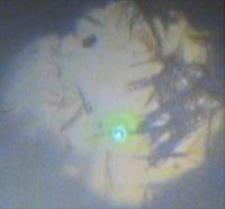 This is a microphotograph of "wurzite" GaAs nanowire in a diamond anvil cell high pressure cavity kept at 99,000 times normal atmospheric pressure (10 gigapascals); a blue spot is from the 488 nm laser spot (about 4 µm in diameter). Credit: Wei Zhou
This is a microphotograph of "wurzite" GaAs nanowire in a diamond anvil cell high pressure cavity kept at 99,000 times normal atmospheric pressure (10 gigapascals); a blue spot is from the 488 nm laser spot (about 4 µm in diameter). Credit: Wei Zhou
A team of researchers has analyzed a new approach for tuning of gallium arsenide (GaAs). This material possesses natural semiconducting properties. The nanoparticle and nanowire form of GaAs can be used in applications where silicon is being presently used, such as in the manufacture of optoelectronics and solar cells.
However, there are some hurdles, and in order to increase gallium arsenide’s attractiveness for widespread usage, it requires a bit of tuning. When a specific amount of energy is applied to a semiconducting material, its bound electrons move to conducting states, increasing its conductivity. The amount of energy needed to induce the electrons to move to a higher-energy state is called as the “band gap,” and fine-tuning this gap has advantages.
The research team used very high pressure for tweaking the band gap. This high pressure modified gallium arsenide’s electron-carrier properties. In earlier studies, researchers had used nanowires made from gallium arsenide with "zincblende" structure, and found that under application of pressure, the band gap widened. In the present study, the research team used nanowires with "wurtzite" structure. High pressure in the order of 23GPa was applied on these wires in diamond anvil cells. The widening of the band gap was found to be much less than when "zincblende" crystal nanowires were used. At a pressure of 21GPa, a structural change occurred in the "wurtzite" gallium arsenide nanowires. A new "orthorhombic" phase was induced and this may provide metallic electronic properties to the material.
The study suggests that when the two gallium arsenide structure types are possibly used in a single device, it may help develop more useful electronic functions.
Alexander Goncharov of Carnegie led the research team, which included Jian-Bo Zhang from South China University of Technology, and Wei Zhou, Yu-Qi Wang, Xin-Hua Li and Xiao-Jia Chen from the Chinese Academy of Sciences. This study has been published in Scientific Reports.
References